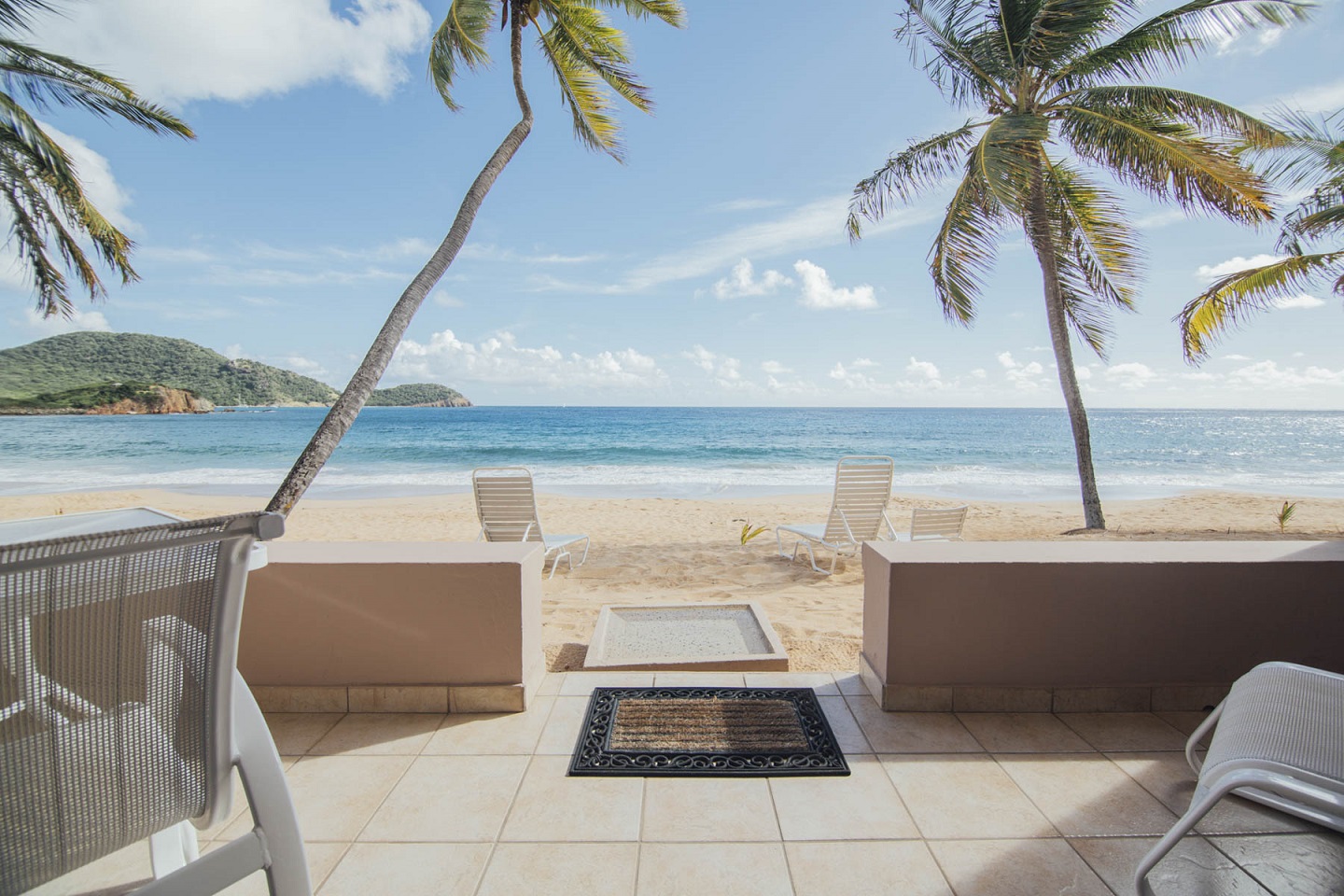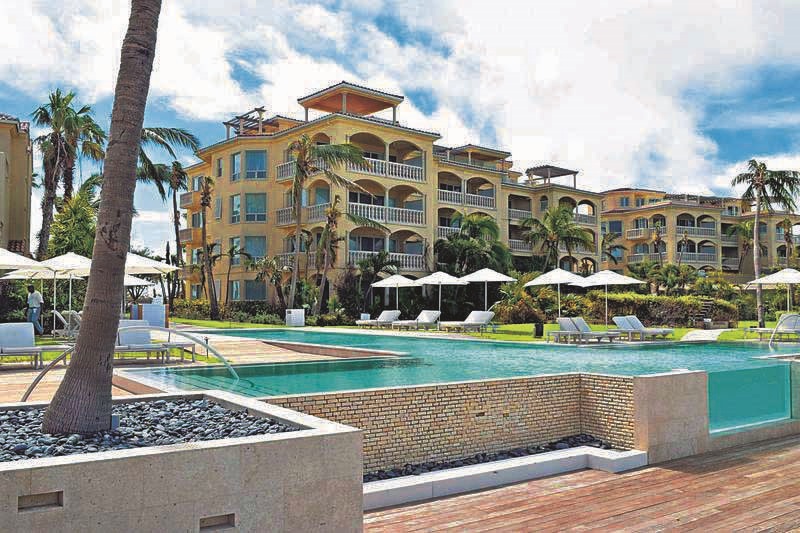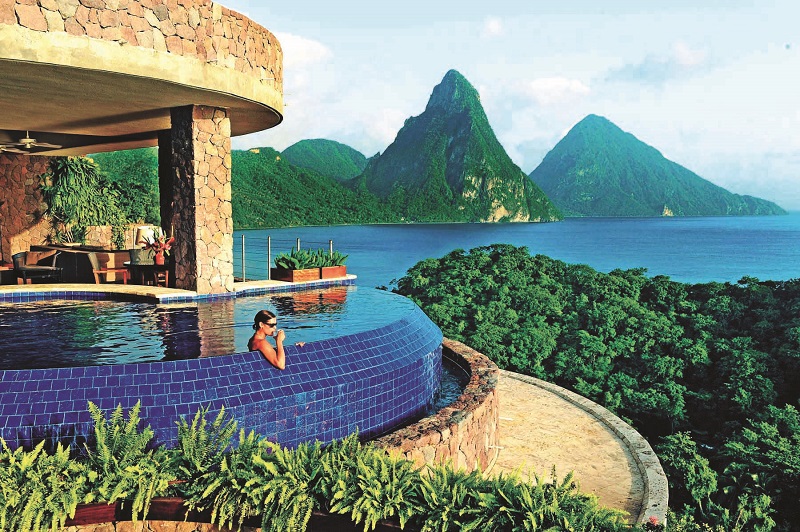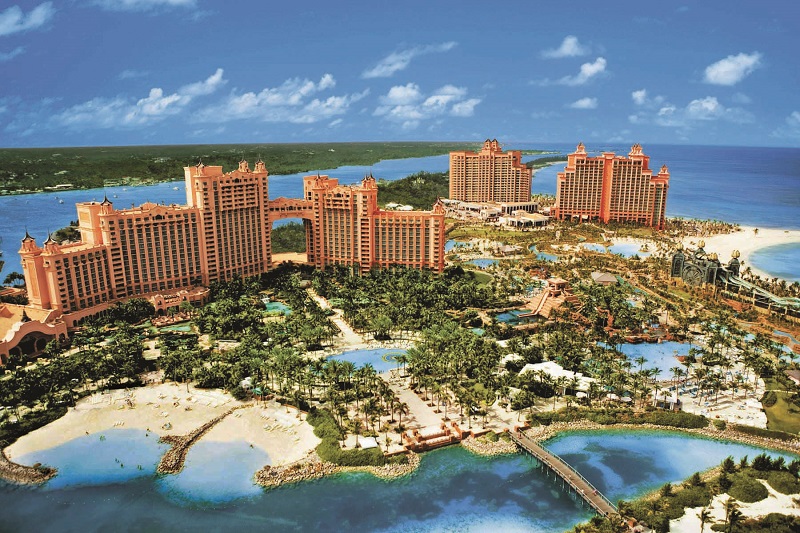
One of two beaches at Curtain Bluff, an all-inclusive five-star resort in Antigua
Just as cruise ships provided much needed relief for evacuees of Caribbean islands during the one-two punches of Hurricanes Irma and Maria, other elements of the local tourism industry are already hard at work helping to get the region back on track.
While governments struggle to get help to devastated residents in Puerto Rico, the Virgin Islands, St Barts, Barbuda, Dominica, and other hard-hit communities, one thing that outsiders can do to help is go visit other islands that made it through relatively unscathed. A majority of the Caribbean islands, where tourism accounts for up to 90% of the overall gross domestic product, still need visitors this winter — both for themselves and to support their suffering neighbours.
“We need people to be part of this economy,” explains Nikheel Advani, chief operating officer and principal of Grace Bay Resorts in Turks and Caicos, a chain of 40 islands that depends on tourism for 85% of its direct and indirect GDP. His resorts recently welcomed their first guests after the hurricanes, with little visible damage beyond a few stripped palm trees. “In the news, everyone is saying that the Caribbean is closed. Taking away the fear right now is key.”
Why? The tourism industry in the Caribbean is not just in the front line of economic impact, it is also in the front line of relief. “We’re operations people,” explains Advani. “We make things happen. We’re decentralising the recovery process, and the government has been open to letting us do what we need to do — they’ve been facilitators, and we [travel professionals] have been the doers.”

For his part, that means coordinating efforts between multiple resorts and aid organisations to distribute materials, raise funds and maximise those dollars to rebuild homes and restore jobs. That is how Providenciales, the island at the nexus of the Turks and Caicos chain, returned to the status quo within three days. With hotels back online, says Advani, it is easier to drum up more fundraising and shift locals from self-help to help-others mode.
Ovation Travel president Jack Ezon, who has been something of a leader in helping hotels and travellers navigate the aftermath, says Advani is in good company. Maurice Bonham Carter, owner of travel agency Island Destinations, has donated US$1 million in relief funds and is matching contributions from the clients for whom he is planning trips; tour company Voyage by Pascale has seeded a US$15,000 fund to help Caribbean schools replenish what they have lost; luxury advisers at Forest Travel have chartered two jumbo jets to send 17 tonnes of supplies and evacuate at-risk locals; and regional charter company Tradewind Aviation has coordinated relief flights. This is hardly a comprehensive list. Patronising these change-makers — and the resorts on the ground that are banding together to make a difference — is the best way to ensure that their efforts continue.
“We need to encourage people to travel and stay in the region,” says Ezon, who had US$18 million in travel bookings in the Caribbean scheduled from September through the holiday season. (Of those bookings, more than half were shifted to unaffected destinations, ranging from Cartagena to Los Cabos.) “This literally puts food on people’s tables. Your luxury is someone else’s necessity.”
“Consumers don’t understand that over 70% of our Caribbean destinations are open as usual,” adds Karolin Troubetzkoy, president of the Caribbean Hotel & Tourism Association and co-owner of St Lucia’s five-star Jade Mountain resort, which was not in either storm’s path. Avoiding these untouched islands will only escalate the Caribbean’s crisis by further damaging its biggest revenue stream.
And ultimately, says Ezon, “It’s all one economy. Providenciales is going to help Grand Turks. Tourism revenues in Antigua will help Barbuda. There’s a ripple effect here that’s very important.” Islands that get back to normal quickly will continue fundraising for their neighbours, until everyone’s back online; weakness in one portion of the Caribbean softens the tourism market for all of them.
With that in mind, we have rounded up an impressive roster of open-for-business hotels that have long set the standard for luxury and are now setting the standard for local philanthropy after Irma and Maria.
Grace Bay Resorts, Turks and Caicos
Why it is a classic: This Providenciales pioneer’s flagship, Grace Bay Club, has something for everyone: There is a low-slung, adults-only wing with super-spacious rooms, family-friendly suites with access to a comprehensive children’s club, and ultra-luxury villas. And despite its broad offerings, the resort still feels intimate and fresh, with loyal staff that have a great eye for detail.
Why go now: Advani has been a key organiser in the regeneration of Turks and Caicos. First, he banded together with nearby resorts Gansevoort, Amanyara and the Palms to cook for displaced locals; together, they have also been rebuilding homes across the island. Now, with Providenciales largely back on its feet, Advani is leveraging his relationships with regional and global tourism organisations (such as the Caribbean Hotels Association, Virtuoso and Small Leading Hotels of the World) to drum up awareness of on-the-ground non-profits.
Bonus: His own GoFundMe campaign, which will help rebuild the homes of Grace Bay staff members and their families, has already raised more than US$24,000, and Advani will soon start offering interest-free loans for further rebuilding.
Jade Mountain, St Lucia
Why it is a classic: A regular on world’s best lists, the family-owned Jade Mountain is best known for the fact that its 29 suites only have three walls apiece. With open, loft-like floor plans that flow seamlessly from living room to bathroom to private plunge pool, they keep your eyes trained on the stunning Pitons, volcanic spires, just across the bay.
Why go now: Co-owner Karolin Troubetzkoy is leading up the “One Caribbean Family” initiative through the Caribbean Hotel & Tourism Association, which is collecting donations to help get the region the support it needs. Through the end of 2018, she will also funnel US$50 to the fund for every booking at Jade Mountain. Guests who donate will get resort credits of up to US$250.

Curtain Bluff, Antigua
Why it is a classic: This all-inclusive playground for the rich and famous is ideal for those who would rather not sit on a beach lounge all day — activities include tennis, squash and deep-sea fishing. But beach it up you should: The resort is set on a strip of land that juts into the ocean, with quiet Caribbean access on one side and big Atlantic waves on the other.
Why go now: Incredibly, Antigua was left unscathed by the storms while Barbuda — less than 160km away — was left devastated, with 95% of its buildings destroyed. So Curtain Bluff is raising funds from donors and travellers via its 43-year-old charitable arm, the Old Road Fund. Already, it has sent more than US$15,000 of material support to its sister island, with more on the way.
Atlantis, Bahamas
Why it is a classic: For families with children of varying ages and varying preferences, there is no better place: The über-resort has programming for toddlers, preteens and teens, plus eight sections of accommodation of varying levels of luxury. In other words, you are well taken care of, no matter what a vacation means to you. The famous waterslide is the icing on the cake.
Why go now: The property has a history of helping out after big storms — its Dolphin Cay was created to give a safe haven to displaced dolphins after Katrina. In the aftermath of Irma and Maria, it has been raising funds through a YouCaring campaign — US$11,000 so far, all going to the Bahamas Red Cross and Red Cross efforts in Florida. The resort will match the first US$250,000 of contributions, dollar for dollar. It has also been offering its amenities to displaced Bahamians: Staff have prepared and served hot meals for locals who lost their homes and families in shelters have been invited to take advantage of the resort’s children’s club, movie nights and game rooms.

Belmond Cap Juluca, Anguilla
Why it is a classic: It is practically paparazzi-proof in its privacy, with 97 rooms and suites scattered among a series of Moroccan-inspired bungalows — many with whitewashed beams, solariums and Moorish archways.
Why go now: The hotel’s new general manager, Tiago Sarmento, arrived on the island only a month before the storms — on the heels of the hotel’s acquisition by Belmond. But his response to the hurricanes should cement his place in the community: He has been delivering supplies from his hotel to employees in need and started a relief fund that has already raised US$28,000 for the immediate community. A second fund will help locals not just on Anguilla but also on St Martin, which is home to Belmond’s La Samanna resort. All proceeds will be matched.
The Shore Club, Turks and Caicos
Why it is a classic: A relative newcomer, the Shore Club chucks aside the traditional island vernacular in favour of a super-clean, white-on-white look. Think cocoon-like hammock chairs; sleek, wood-panelled cabanas and wraparound, floor-to-ceiling windows.
Why go now: Along with its sister resorts — the Palms and the Sands at Grace Bay — the Shore Club has been working in tandem with the Salvation Army, the United Nations and several other organisations to get their neighbours back to speed. Its main contribution? Offering its ballroom to a local church to house displaced members of the community and serve as a makeshift gathering space. — Bloomberg


